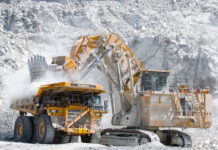
THE US government confirmed in February its intention to remove all exemptions and restore section 232 import tariffs on steel (25%) and aluminium (25%, up from 10%).
Effective on Tuesday for Mexico and Canada (March 4), President Donald Trump will decide whether his administration will stick with the targets.
Setting aside this uncertainty for now, the question is how might the tariffs affect the world’s metals sector, and the companies that produce them?
Based on similar tariffs in his first presidency, implemented in 2018, up to 80% of the increases will be borne by US importers, says Goldman Sachs.
The balance may reflect on lower producer/exporter prices in order for the duty increase to be satisfied, it said. For companies such as Australian diversified miner Rio Tinto, that’s equal to a 1% hit on group earnings before interest, tax, depreciation and amortisation (ebitda) — 5% of ebitda of its aluminium division.
“Commodities [function] so early in the value chain that there are a lot of steps before [tariffs] flow through to the end price [for] the customer,” Julian Grieve, head of resources at RMB, said in an interview with Miningmx last month.
“Steel pipe prices change every day, but the value of a Volkswagen doesn’t change so quickly,” he said. “But what is being alleged [by Trump] and what will be executed are very different things. Timing is so uncertain.”
South32 CEO Graham Kerr plays down the potential impact of the tariffs.
As a portion of total group revenue, about 9% of sales is in the US. In terms of aluminium production, it’s about 13%, based on South32’s interim ebitda to end-December. Speaking to analysts in February, Kerr said there was “only one person” who has a sense of where US tariffs are heading.
Unless new aluminium production is incentivised in the US, there’s little long-term threat to the group’s business, Kerr said. “The last time we had tariffs in place we didn’t see an inducement of US production. Unless you see big inducements of new smelters in the US it’s probably not going to make a big difference on our book, from our perspective.”
Kerr acknowledged that tariffs, if they are implemented as envisaged now, could have a long-term effect on critical components such as palladium.
Like so much of the Trump administration’s economic approach, tariffs are inflationary and may ultimately manifest in a higher interest rate. Both developments would hurt the consumption of consumer goods, such as the buying of new vehicles. A significant slowdown in the automotive market is the very last thing autocatalyst suppliers such as South Africa’s platinum group metal (PGM) miners need right now.
The average rand basket price for PGMs for Anglo American Platinum (Amplats) declined 13% in the six months to December 31, driven by multi-year price lows for palladium and rhodium, which fell 24% and 30% respectively.
“Tariffs do result in higher costs, which are borne by the end users and will drive both inflation and interest rates higher,” said Amplats CEO, Craig Miller. “This may weigh on people’s ability to replace motor vehicles and affect PGM demand. But in terms of medium-term demand we continue to see people wanting to own a motor vehicle for their own mobility.
“The electrification of the drivetrain will slow down, in total percentage terms, against the number of internal combustion engine or hybrid cars that contain catalytic converters,” he said. “It won’t change the deficits in platinum, palladium and rhodium for 2025.”











